
Advanced Search
IAN ID:
PASSWORD:
Forgot ID or Password?
Join IAN to participate in discussions and receive updates
Click here to visit IAN Research.
IAN Home About IAN About ASDs Newly Diagnosed Challenging Behaviors Therapies
& Treatments Seeking Answers: Trying Anything and Everything What Do We
Really Know? Evaluating Treatments How IAN Research Can Make a Difference IAN
Treatment Reports Introduction Speech and Language Therapy Occupational Therapy
Medication Special Diets Social Skills Groups Transporters Article Child Psychiatry
and Autism Behavior Therapy Beyond Childhood Can Antipsychotic Medication Help
My Child? Autism and Health Care: Sticker Shock All About Research Adults For
Researchers IAN Articles Discussion In the News Newsletters Glossary Most Emailed
Past Polls Home non-flash
Home | Therapies & Treatments | IAN Treatment Reports | Social Skills Groups
* Print-Friendly
* E-mail a Friend
* Text: Normal - Large
* Bookmark and Share
* | JOIN:
*
*
*
IAN Research Findings: Social Skills Groups
Date First Published: February 11, 2009
The Interactive Autism Network (IAN), a project collecting information online from families of children with autism spectrum disorders (ASD) throughout the United States, reports that more than 14% of participating children are taking part in a social skills group. This percentage is even higher for older children, and children with PDD-NOS or Asperger's syndrome. Such groups are intended to address the core social deficit in ASD by improving social understanding and interaction. What research has been done on such interventions? What do families report about their experience with social skills groups?
IAN is a web project of the Kennedy Krieger Institute sponsored by Autism Speaks.
Please Note: These Findings Are Preliminary
The analyses presented here by the Interactive Autism Network are preliminary.
They are based on information submitted over the Internet by parents of children
with autism spectrum disorders (ASDs) from the United States who choose to participate.
They may not generalize to the larger population of children with autism spectrum
disorders. The data have not been peer-reviewed -- that is, undergone evaluation
by researchers expert in a particular field -- or been submitted for publication.
IAN views participating families as research partners, and shares such preliminary
information to thank them and demonstrate the importance of their ongoing involvement.
We encourage autism researchers investigating these topics to apply for access
to the IAN database. Contact researchteam@ianproject.org.
Social Interventions in Autism
An inability to process the social world is a key feature of autism. Researchers have worked to describe and understand the wide range of social deficits exhibited by people on the autism spectrum, including unusual eye gaze, impaired joint attention, and a lack of theory of mind, that is, an ability to attribute beliefs, intents, desires or other mental states to oneself and others, and to understand that these may be different in other people. How do "typical" people naturally establish eye contact, learn the "rules of conversation," or intuit what others know, feel, or intend? How are people with ASDs different? Knowing this is a first step to developing interventions that will help them compensate for what they lack: natural social connectedness and insight.
Many socially based interventions have been developed in the trenches, so to speak, by clinicians, therapists, and educators trying to find a way to assist their clients and students on the spectrum. After all, addressing social challenges can be critical to success at school, at work, or in the larger world. Improved social functioning can also lead to more and better relationships -- something that may have a direct impact on mental health by preventing the feelings of isolation and loneliness that many older children and adolescents with ASD express. 1
The list of social skills programs and tools offered in schools and clinics is a long one, including:
(To read an article about one such project, see Transported to a World of Emotion by Simon Baron-Cohen and colleagues.)
Many of the tools described can be used in the context of a social skills group. There is no single formula for what such a group consists of, but the general idea is to bring individuals together to learn social skills and to practice them together in real time (since learning something social will likely require human interaction). Exactly what is learned depends a great deal on the needs of the group. Younger children might focus on the social rules they would encounter at a birthday party, for example, while older individuals might focus on dating and relationships, or situations in the work place.
(To learn more about research on Social Skills Groups, read on. Or , if you prefer, skip ahead to the section on the experience of families participating in IAN Research.)
Social Skills Groups: What Does Research Tell Us So Far?
Research on the effectiveness of social skills groups, just like research on social skills interventions more generally, has been fairly limited. 17 Research so far has consisted mostly of studies focused on a single social skills group. In other words, those working with individuals on the autism spectrum have described how a specific social skills group was organized, and have provided ratings of participants' skills before and after the intervention. Such studies provide a first glimpse into what techniques are being tried, and if they seem to have worked. If encouraging, they can point the way towards higher level, more complex, and more conclusive research.
An example of such a study comes from Texas A&M University. Researchers there set out to examine the effectiveness of an outpatient social skills group for children ages 6 through 9 with high-functioning autism. Only four children participated. Group instruction targeted specific social skills, such as greetings, conversation, and play skills. Following each of eight sessions, the children with autism were observed in play sessions with typical peers who had received some instruction on ways to interact with children on the autism spectrum. Unfortunately, even with the inclusion of typical peers as part of the intervention, parents reported that only greeting skills had improved in social situations outside of treatment. Still, the children who participated reported feeling they had more social support from classmates at school after those students had received training on how to interact with them -- a beneficial outcome, though not the one the study set out to measure. 18
In another study, eight adolescents with Asperger's syndrome or other high-functioning ASDs worked on nonverbal communication skills. Although the targeted skills did not improve much during the course of the group, friendships developed that seemed to outlast the formal group meetings. 19 Considering that isolation, loneliness, low self-esteem, and even depression can affect adolescents and young adults with ASDs, it may be wise to target such outcomes as one purpose of group-based social skills interventions rather than considering them a side-effect.
Comparing two types of social skills groups is a more complex form of research than looking at a single group, and can provide more insight. Taking such an approach, Kroeger and colleagues set out to evaluate two very different social skills groups. One involved unstructured play; that is, the children had a scheduled time to get together and just play. The other involved direct social skills teaching using a video-modeling format. While children in both groups increased positive social behaviors, those in the direct teaching group made more gains. 20 These findings provide evidence that group interventions can be effective regardless, but that they are most effective when delivered in a direct instruction format -- a finding "consistent with research that indicates repetition and intensity within a structured setting are critical components to teaching social skills to children with autism." (p 815)
Bauminger conducted a fascinating two-phase study on an individual vs. a group social skills intervention, both based on cognitive-behavioral therapy (CBT). In the first phase, children received individual CBT based social skills training. In the second phase, these same children, plus others who had not received individual training, took part in a group social skills program. 21,22 Children who participated in the group intervention showed improvement in recognizing emotions and understanding others' perspectives. They improved in cooperative social interaction as well, at least within the context of the group. Unfortunately, these social interaction gains were observed beyond the group only for the children who had also received the individual intervention.
It is interesting to note that the individual training had included components that were specifically intended to help the children generalize their new skills, that is, to help them apply them in settings other than the one where they learned them. Each child had met with a peer during school recess and at home to underscore skills learned during therapy, and parents had been urged to learn and emphasize the social skills lessons at home, too. The group intervention, in contrast, had not required practicing with peers or at home. The researchers concluded that building in such "beyond the group" practice might well be essential if children participating in a group intervention are to generalize their new skills to other settings and circumstances.
When researchers review a number of studies addressing a similar treatment, they can begin to identify what seems to work across all of them. Reviewing five studies on social skills groups, for example, researchers at the University of Utah and the U.C. Davis M.I.N.D. Institute attempted to identify some "essential ingredients" for an effective social skills group. 23 These central principles were:
Susan Williams White and her colleagues reviewed fourteen studies on group-based social skills training programs. 24 They concluded that clinicians and educators have developed and refined some social skills techniques, and have begun to organize procedures for various social skills programs in treatment manuals. (This is an important step, as it permits knowledge to be shared and research to be replicated.) What is needed next, they declare, are randomized controlled trials (RCTs) that will involve at least two groups for comparison, with participants assigned randomly to each, and with "blinded" participants and researchers.
(To learn more about RCTs, read Gold Standard of Evidence: The Randomized Controlled Trial [RCT].)
Once a program's superior effectiveness can be demonstrated through a randomized controlled trial, studies can take place to show if it can be meaningfully conducted in settings outside of research centers, like schools or clinics. Such research is urgently needed.
In the meantime, thousands of children are participating in social skills groups on a regular basis. What do families participating in the IAN Research project report about their experience of social skills groups?
IAN Families Report on Social Skills Groups
IAN families have reported on 34,646 autism treatments, from vitamins to medications, from educational programs to diets. Of these treatments, 1,672 -- or 4.8% -- are some type of social skills intervention. In many cases, children are receiving more than one social intervention at a time. Of the 6,592 children whose parents have provided treatment data, 942 -- or 14.3%-- are taking part in a social skills group.
As might be expected, because social skills groups can be adapted to meet very different needs over the life span, children of all ages are participating in them (see Figure 1).
Figure 1.

Social skills groups are also used by children of all autism spectrum diagnoses, although it appears they are used even more frequently to treat children with pervasive developmental disorder not otherwise specified (PDD-NOS) and Asperger's syndrome (see Figure 2). As we have seen, many social skills techniques attempt to directly teach information about social or emotional aspects of life. This may mean they are most effective for children whose cognitive ability is a relative strength. It may also mean that this is an intervention offered to higher functioning, more verbal, later diagnosed children who may never have received intensive early intervention such as applied behavior analysis (ABA).
Figure 2.
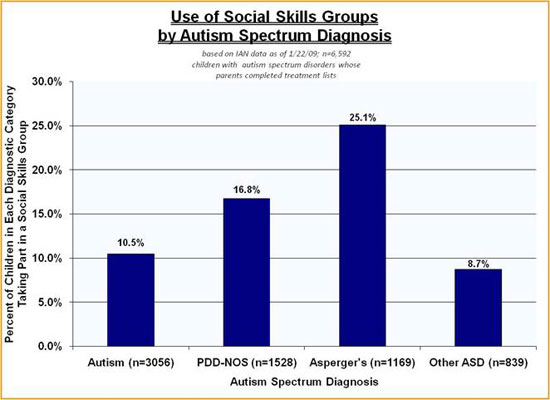
Targeted Symptoms
Approximately 700 parents have reported in detail on social skills groups. The symptoms parents told us they hope to target are fairly specific: communication and social functioning are uppermost (see Figure 3).
Figure 3.
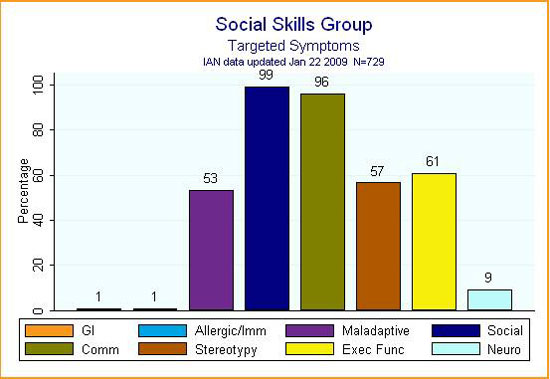
Allergic/Imm = issues involving allergic reactions or the immune system; Maladaptive = dysfunctional behaviors such as meltdowns or self-injury; Social = social skills of all kinds; Comm = communication; Stereotypy = stereotyped or repetitive behaviors; Exec Func = executive function; Neuro = neurological)
Funding Sources, Insurance, and Out-of-Pocket Cost
More than 60% of parents report their child's social skills group is funded by a public school, an early childhood program, or some other non-Medicaid program. Thirty-seven percent are receiving no public funding for the treatment at all (see Figure 4).
Figure 4.
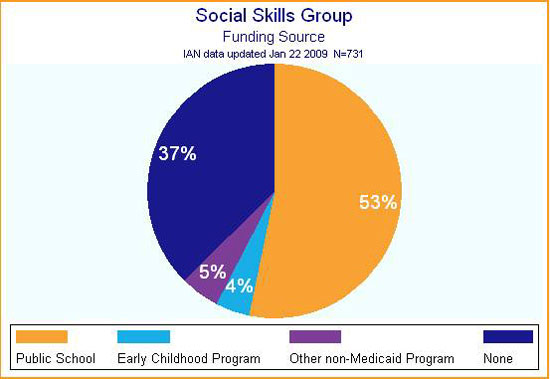
(Note: Numbers do not add to 100% due to rounding.)
Those who enroll in a social skills group outside a public school or other public program generally have to pay out of pocket. Insurance rarely covers this treatment (see Figure 5).
Figure 5.

(Note: Numbers do not add to 100% due to rounding.)
The cost of this treatment varies. More than 60% report that the intervention cost them nothing, which makes sense considering it is around 60% who say they receive social skills group funding via a public program, like the local school. For the majority of the rest, however, the cost of participating in such a group is between $101 and $500 per month (see Figure 6).
Figure 6.
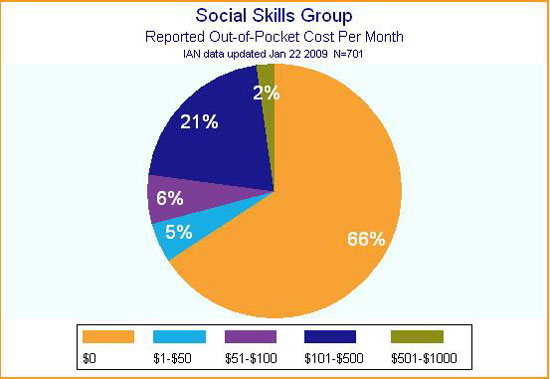
Expectations, Risks, and Experience
As children embark on this therapy, many parents hope it will yield at least moderate improvement, though only 20% of parents expect "high" or "very high" levels of improvement (see Figure 7).
Figure 7.
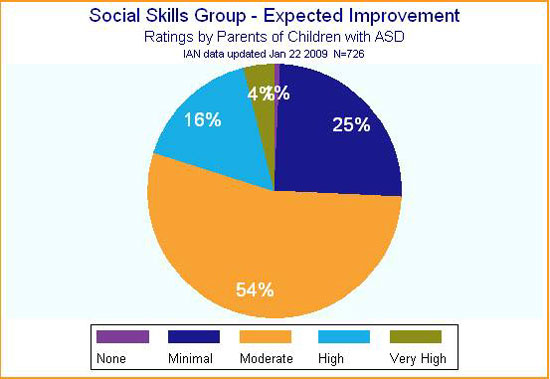
At the same time, the vast majority of parents feel there is no or very little potential risk involved with trying a social skills group (see Figure 8). (Low risk is an attractive aspect of any proposed treatment.)
Figure 8.
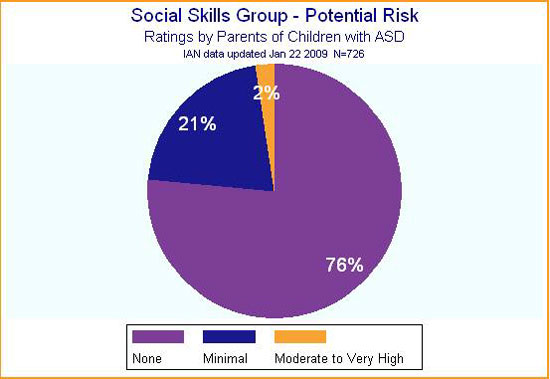
(Note: Numbers do not add to 100% due to rounding.)
Those who have reported on their experience with the treatment give it high marks, with 77% saying it led to improvement. Reports on how great that improvement was were varied, however, with 20% saying "minimal," 50% saying "moderate," and 30% saying "high" or "very high" (see Figure 9).
Figure 9.

A word of caution: The information reported here reflects only parents' evaluation of current treatments. Because any treatment a child is currently receiving must be considered worthwhile by parents, we expect ratings to be fairly high at this point. As data are collected over time, and families can report on treatments they have dropped, there likely will be more negative reports, not just on this treatment, but on many treatments. Add to this the major impact of the placebo effect found in many autism treatment studies, and it is wise to take these findings as very preliminary and as yet incomplete.
Research on Social Skills Groups -- Next Steps
Many questions remain, of course. What were these social skills groups? What aspects of social functioning were they intended to improve, and how did they target these? How appropriate were interventions to developmental social-emotional level, and were children able to build on social skills as they laid social foundations, brick by brick? Were children able to generalize the skills they learned in these groups to other situations? To what extent do these groups simply function as support groups for the children, and to what extent do they truly improve social cognition and social functioning?
A great many children with ASDs are taking part in social skills groups, and much time, effort, and money is being devoted to these. It is therefore crucial that autism researchers identify promising group-based social skills programs, complete with manuals describing in detail how they should be conducted, and carry out randomized controlled trials to test their ultimate effectiveness.
Great strides have been made towards showing social skills groups can be an effective autism intervention. Unfortunately, we still have a great distance to go before evidence-based social skills programs are easily available to every school and clinic.
1. Bauminger, N., Shulman, C., & Agam, G. (2003). Peer interaction and
loneliness in high-functioning children with autism. Journal of Autism and Developmental
Disorders, 33(5), 489-507.
2. Dawson, G. (2008). Early behavioral intervention, brain plasticity, and the
prevention of autism spectrum disorder. Development and Psychopathology, 20(3),
775-803.
3. Bauminger, N. (2007). Brief report: Individual social-multi-modal intervention
for HFASD. Journal of Autism and Developmental Disorders, 37(8), 1593-1604.
4. Bauminger, N. (2007). Brief report: Group social-multi-modal intervention
for HFASD. Journal of Autism and Developmental Disorders, 37(8), 1605-1615.
5. Gray, C. (2000). The new social story book. Arlington, Texas: Future Horizons,
Inc.
6. Hagiwara, T., & Myles, B. S. (1999). A multimedia social story intervention:
Teaching skills to children with autism. Focus on Autism and Other Developmental
Disorders, 14(2), 82-95.
7. Quirmbach, L. M., Lincoln, A. J., Feinberg-Gizzo, M. J., Ingersoll, B. R.,
& Andrews, S. M. (2009). Social stories: Mechanisms of effectiveness in
increasing game play skills in children diagnosed with autism spectrum disorder
using a pretest posttest repeated measures randomized control group design.
Journal of Autism and Developmental Disorders, 38(2), 353-361.
8. Goldstein, H., & Cisar, C. L. (1992). Promoting interaction during sociodramatic
play: Teaching scripts to typical preschoolers and classmates with disabilities.
Journal of Applied Behavior Analysis, 25(2), 265-280.
9. Krantz, P. J., & McClannahan, L. E. (1993). Teaching children with autism
to initiate to peers: Effects of a script-fading procedure. Journal of Applied
Behavior Analysis, 26(1), 121-132.
10. Krantz, P. J., & McClannahan, L. E. (1998). Social interaction skills
for children with autism: A script-fading procedure for beginning readers. Journal
of Applied Behavior Analysis, 31(2), 191-202.
11. Weiss, M. J., & Harris, S. L. (2001). Teaching social skills to people
with autism. Behavior Modification, 25(5), 785-802.
12. Myles, B. S., Trautman, M., & Schelvan, R. L. (2004). The hidden curriculum:
Practical solutions for understanding unstated rules in social situations. Shawnee
Mission, KS: Autism Asperger Publishing Co.
13. Charlop, M. H., & Milstein, J. P. (1989). Teaching autistic children
conversational speech using video modeling. Journal of Applied Behavior Analysis,
22(3) 275-285.
14. LeBlanc, L. A., Coates, A. M., Daneshvar, S., Charlop-Christy, M. H., Morris,
C., & Lancaster, B. M. (2003). Using video modeling and reinforcement to
teach perspective-taking skills to children with autism. Journal of Applied
Behavior Analysis, 36(2), 253-257.
15. Kroeger, K. A., Schultz, J. R., & Newsom, C. (2007). A comparison of
two group-delivered social skills programs for young children with autism. Journal
of Autism and Developmental Disorders, 37(5), 808-817.
16. Golan, O., & Baron-Cohen, S. (2006). Systemizing empathy: Teaching adults
with Asperger syndrome or high-functioning autism to recognize complex emotions
using interactive multimedia. Development and Psychopathology, 18(2) 591-617.
17. Rao, P. A., Beidel, D. C., & Murray, M. J. (2008). Social skills interventions
for children with Asperger's syndrome or high-functioning autism: A review and
recommendations. Journal of Autism and Developmental Disorders, 38(2), 353-361.
18. Barry, T. D., Klinger, L. G., Lee, J. M., Palardy, N., Gilmore, T., &
Bodin, S. D. (2003). Examining the effectiveness of an outpatient clinic-based
social skills group for high-functioning children with autism. Journal of Autism
and Developmental Disorders, 33(6), 685-701.
19. Barnhill, G., Cook, K. T., Tebbenkamp, K., & Myles, B. S. (2002). The
effectiveness of social skills intervention targeting nonverbal communication
for adolescents with Asperger syndrome and related pervasive developmental delays.
Focus on Autism and Other Developmental Disorders, 17(2), 112-118.
20. Kroeger, K. A., Schultz, J. R., & Newsom, C. (2007). A comparison of
two group-delivered social skills programs for young children with autism. Journal
of Autism and Developmental Disorders, 37(5), 808-817.
21. Bauminger, N. (2007). Brief report: Individual social-multi-modal intervention
for HFASD. Journal of Autism and Developmental Disorders, 37(8), 1593-1604.
22. Bauminger, N. (2007). Brief report: Group social-multi-modal intervention
for HFASD. Journal of Autism and Developmental Disorders, 37(8), 1605-1615.
23. Krasny, L., Williams, B. J., Provencal, S., & Ozonoff, S. (2003). Social
skills interventions for the autism spectrum: Essential ingredients and a model
curriculum. Child and Adolescent Psychiatric Clinics of North America, 12(1),
107-122.
24. Williams White, S., Koenig, K., & Scahill, L. (2007). Social skills
development in children with autism spectrum disorders: A review of the intervention
research. Journal of Autism and Developmental Disorders, 37(10), 1858-1868.